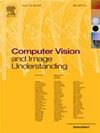学习为视觉变形器预训练遮罩和排列视觉标记
IF 4.3
3区 计算机科学
Q2 COMPUTER SCIENCE, ARTIFICIAL INTELLIGENCE
引用次数: 0
摘要
使用自我监督预训练已经成为一种很有前途的方法来提高许多不同视觉任务的表现。在这种情况下,最近的方法采用了掩膜图像建模范式,该范式通过重建与随机掩膜图像补丁相关的视觉标记来预训练主干。然而,这种屏蔽方法在预训练期间将噪声引入输入数据,导致在微调阶段可能影响性能的差异。此外,输入屏蔽忽略了损坏补丁之间的依赖关系,增加了下游微调任务中观察到的不一致性。为了克服这些问题,我们提出了一种新的自监督预训练方法,称为掩膜和排列视觉变压器(MaPeT),它采用自回归和排列预测来捕获补丁内依赖关系。此外,MaPeT使用辅助位置信息来减少预训练和微调阶段之间的差异。在我们的实验中,我们采用了一个公平的设置来确保可靠和有意义的比较,并对多个视觉标记器进行了调查,包括我们提出的直接使用离散CLIP特征的k-CLIP。我们的结果表明,在相同的模型设置下,与基线和竞争对手相比,MaPeT在ImageNet上取得了具有竞争力的性能。我们在https://github.com/aimagelab/MaPeT上发布了代码和模型的实现。本文章由计算机程序翻译,如有差异,请以英文原文为准。
Learning to mask and permute visual tokens for Vision Transformer pre-training
The use of self-supervised pre-training has emerged as a promising approach to enhance the performance of many different visual tasks. In this context, recent approaches have employed the Masked Image Modeling paradigm, which pre-trains a backbone by reconstructing visual tokens associated with randomly masked image patches. This masking approach, however, introduces noise into the input data during pre-training, leading to discrepancies that can impair performance during the fine-tuning phase. Furthermore, input masking neglects the dependencies between corrupted patches, increasing the inconsistencies observed in downstream fine-tuning tasks. To overcome these issues, we propose a new self-supervised pre-training approach, named Masked and Permuted Vision Transformer (MaPeT), that employs autoregressive and permuted predictions to capture intra-patch dependencies. In addition, MaPeT employs auxiliary positional information to reduce the disparity between the pre-training and fine-tuning phases. In our experiments, we employ a fair setting to ensure reliable and meaningful comparisons and conduct investigations on multiple visual tokenizers, including our proposed -CLIP which directly employs discretized CLIP features. Our results demonstrate that MaPeT achieves competitive performance on ImageNet, compared to baselines and competitors under the same model setting. We release an implementation of our code and models at https://github.com/aimagelab/MaPeT.
求助全文
通过发布文献求助,成功后即可免费获取论文全文。
去求助
来源期刊

Computer Vision and Image Understanding
工程技术-工程:电子与电气
CiteScore
7.80
自引率
4.40%
发文量
112
审稿时长
79 days
期刊介绍:
The central focus of this journal is the computer analysis of pictorial information. Computer Vision and Image Understanding publishes papers covering all aspects of image analysis from the low-level, iconic processes of early vision to the high-level, symbolic processes of recognition and interpretation. A wide range of topics in the image understanding area is covered, including papers offering insights that differ from predominant views.
Research Areas Include:
• Theory
• Early vision
• Data structures and representations
• Shape
• Range
• Motion
• Matching and recognition
• Architecture and languages
• Vision systems
 求助内容:
求助内容: 应助结果提醒方式:
应助结果提醒方式:


